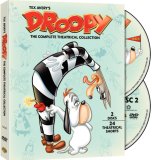| Reviews & Columns |
|
Reviews DVD TV on DVD Blu-ray 4K UHD International DVDs In Theaters Reviews by Studio Video Games Features Collector Series DVDs Easter Egg Database Interviews DVD Talk Radio Feature Articles Columns Anime Talk DVD Savant Horror DVDs The M.O.D. Squad Art House HD Talk Silent DVD
|
DVD Talk Forum |
|
|
| Resources |
|
DVD Price Search Customer Service #'s RCE Info Links |
|
Columns
|
|
|
Tex Avery's Droopy - The Complete Theatrical Collection
THE SHOW:
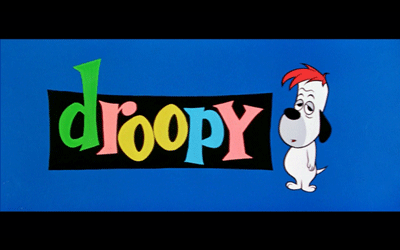
Tex Avery is the first animation director I knew by name. When I was very young, KTLA in Los Angeles showed a two-night retrospective of his work that included documentary segments that explained who he was and the arc of his career from Warner Bros. to MGM. I was immediately taken by Avery's ribald sense of humor and irreverent attitude, his exaggerated reaction shots, slapstick, and visual puns. It was because of that program that I started to pay attention to the credits on animated shorts. I knew to look for ones with Tex's name at the beginning, because those were guaranteed to be funny.
Of course, one of Tex's most famous creations is Droopy, the laconic basset hound who always manages to get the upper hand despite his deadpan delivery and slowpoke demeanor. Droopy is instantly loveable, the quintessential underdog, if you will. He looks perpetually sad, so much so that when he's happy, he has to tell you, and to look at him wouldn't inspire much confidence, but he always manages to pull through in the end.
The double-DVD set Tex Avery's Droopy - The Complete Theatrical Collection has the twenty-four Droopy cartoons shown before MGM features from 1943 to 1958. Seventeen of the first eighteen were directed by Tex Avery, the final six by Michael Lah, who worked in Avery's animation crew. (The packaging fails to mention that Dick Lundy actually helmed cartoon #12, "Caballero Droopy.") The final seven were also made in widescreen CinemaScope, and that aspect ratio is preserved here. Additionally, the cartoons are put on disc in their proper chronological order, allowing one to see the evolution of the series, including Droopy's physical changes over the years.
There are two common formulas to the Droopy cartoons, and they are particularly evident in the early set of programs. One is the format set up in the character's debut, "Dumb-Hounded." In it, the Wolf escapes from prison. He quickly eludes the pack of bloodhounds sent after him--except for Droopy. He goes to great lengths to escape the little dog, executing schemes that always backfire. No matter how far or fast the Wolf runs, Droopy always catches up with him. Variations on the chase theme include the Wolf trying to kidnap the beautiful showgirl and Droopy coming to her rescue. In these features, namely "Wild and Woolfy" and "Northwest Hounded Police," there is always a beautifully animated dance number as choreographed by animation master Preston Blair. More modern audiences will know these dances for the big influence they had on the Jessica Rabbit performance in Who Framed Roger Rabbit?
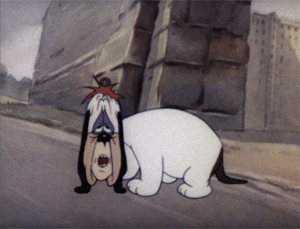
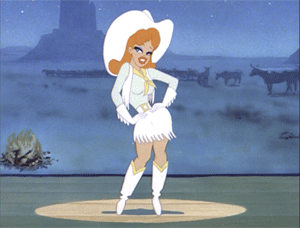
The second and more dominant formula involves Droopy in some kind of competition where his rival does whatever he can to get Droopy out of the race only to always fall prey to his own set-up. Though this formula can also involve the Wolf, such as the bullfight battle in "Señor Droopy," it usually is reserved for Spike the Bulldog (also called Butch or the Gorgeous Gorillawitz). Whether they are competing for a great fortune ("Wags to Riches") or the kiss of a comely lass ("The Chump Champ"), Spike always thinks he can get the upper hand, but he never does. In the latter half of the series, this morphs into battles between Droopy and the Wolf in all sorts of different scenarios, including multiple excursions into the Western genre.
Naturally, not all the cartoons stick to the two formulas, or even the two villains. For instance, "Out-Foxed" combines both the chase and the competition and pits Droopy against his fellow hunting dogs to be the first to catch a tea-drinking, blue-blooded fox. Then, of course, there is the addition of Droopy's twin "Drippy" for "Droopy's Double Trouble," the two extra brothers for "Three Little Pups," and Droopy's child in "Homesteader Droopy." In the case of "Dixieland Droopy," Avery breaks the model completely, and the story is concerned only with our hero searching for a place to play his beloved record, leading to him getting involved with a musical flea circus.
Regardless of the plot construct, however, what the Droopy cartoons do all have in common is their unbridled sense of humor. Avery's MGM work stands apart from his Looney Tunes due to their ramped-up emphasis on sight gags. The faster, the more violent, and the more outrageous the better. In fact, you can see the pace escalate from short to short, another bonus of sequencing the cartoons in chronological order. Some gags are recycled (the Wolf running out of the edge of the film frame when turning a sharp corner, various reactions to explosions or getting shot, the Oscar-nominated "One Droopy Knight" is a do-over of "Señor Droopy," trading the bull for the dragon and the Wolf for Spike, etc.), but for the most part, the jokes remain freewheeling and there is no real limit to how far Avery will take them. He often breaks the fourth wall, having characters refer to the fact that they are in a cartoon, letting them draw over the top of their own image, or having Droopy address the audience. There is even a bit of live-action footage in "Señor Droopy," when the triumphant dog gets to canoodle with beautiful actress Lina Romay.
The other thing they have in common is consistently slick animation. While Disney has always ruled when it came to animated features, I submit that MGM had the best short subject crews. The animation in Droopy - The Complete Theatrical Collection is far cleaner and better drawn than either the of the libraries at Warner Bros. or Disney. It's particularly impressive when you look at the speed with which everything moves and the increasing reliance on sight gags. The artists don't falter, the quality of the work never gets sacrificed for a joke.
As time marches on, the style changes some. The drawings get more angular in the 1950s, looking a little more like the design work of Chuck Jones. The backgrounds in "Dixieland Droopy" even have a Maurice Noble feel, and signals the sea change in the overall look and feel of Droopy cartoons. It's co-directed by Avery and Lah, and Avery's last remaining solo effort would be "Millionaire Droopy." It's the first in the widescreen shorts, but it's also a shot-by-shot remake of "Wags To Riches." From there, Lah would take over, and I actually really enjoy the new visual style. The MGM animators take very well to the expressive freedom it provides. Not so good, though, is that by this point, Droopy isn't quite the same hound we met back in "Dumb-Hounded." He's far less the slowpoke sadsack, and instead just a quiet, unfrazzled dog with exceptional skills. Or, less like a dog, more like a little old man. It's not a drastic change, and when I describe it, it reads like there is barely any difference. The cartoons are still funny and light years better than the TV versions of Droopy that were on their way, but some of the charm is gone, polished away by popularity.
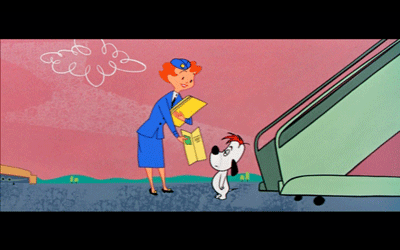
The full list of cartoons on DVD 1:
Dumb-Hounded
The Shooting of Dan McGoo
Wild and Woolfy
Northwest Hounded Police
Señor Droopy
Wags to Riches
Out-Foxed
The Chump Champ
Daredevil Droopy
Droopy's Good Deed
Droopy's Double Trouble
Caballero Droopy
The full list of cartoons on DVD 2:
The Three Little Pups
Drag-A-Long Droopy
Homesteader Droopy
Dixieland Droopy
Millionaire Droopy
Grin and Share It
Blackboard Jumble
One Droopy Knight
Sheep Wrecked
Mutts About Racing
Droopy Leprechaun
From what I can tell, none of these cartoons have been altered for content. There are a couple of instances of race-related humor, and they remain intact. Spike, causing an explosion, walks away with a semblance of black face in cartoons like "Wags to Riches" and "Daredevil Droopy," as does the Wolf in "Three Little Pups" and "Blackboard Jumble." A quick joke with Native Americans in a teepee is in "Drag-A-Long Droopy." The most extreme is "Droopy's Good Deeds," which has two black-face gags along with vocal stereotypes and Droopy referring to Spike as "Blackie" when he is in this state. I prefer these things be kept in, myself, rather than sweep them under the carpet. These scenes remaining would suggest there was no censorship. If there was something snipped, my apologies, my memory is not such that, if I ever saw these cartoons in their full running, I'd remember them exactly. There are warnings all over the box, too, letting us now that "Droopy - The Complete Theatrical Collection is intended for the Adult Collector and May Not Be Suitable for Children." A disclaimer also runs at the start of each DVD.
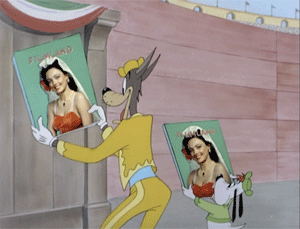
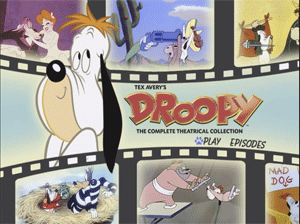
THE DVD
Video:
I'm disappointed to say that it looks like Warner Brothers hasn't done a whole hell of a lot to clean up these cartoons for DVD release. Despite boasting new 16X9 transfers for the last seven shorts in the collection, they are understandably quiet when it comes to the fullscreen cartoons. From the looks of things, their version of due diligence on this project may only have been to find the best looking copy in their archives to master the DVDs from, but they stopped short of actually doing anything to fix the cartoons up. This means the shorts often have dull colors and lots of surface grime and scratches. Some are better than others. For instance, "Daredevil Droopy" looks pretty good. The flipside, however, is that some are worse. The first cartoon, "Dumb-Hounded," looks washed out, and "Three Little Pups" starts out bright but then gets dark. The true bottom of the barrel, "Out-Foxed," has multiple problems. Besides having the most noise on the image, there is also a really horrendous splice near the end of the cartoon. After a quick skip and a flash of purple, you'll see a dramatic drop in picture resolution and color tone. It almost looks like they shifted from a film negative to a VHS dub.
What with mistakes made in the first two Tom & Jerry sets, you'd think Warners would start giving a little more respect to their MGM cartoon library. No such luck. I don't want to overstate it. It's not like these look like public domain knock-offs of some TV station's syndication prints or anything, but seriously, it's clear they could have done better. In fact, they show that themselves with the seven widescreen cartoons. They clearly did something with those to pretty them up, as they are almost completely free of glitches. Why not the same for the earlier, better 'toons?
Sound:
The audio, on the other hand, is not so bad. The mono mix can be a little hollow sounding at times, but overall, a decent job. Nothing stands out as great, but I have no specific gripes, either.
Extras:
DVD 2 has two bonus features.
The eighteen-minute "Droopy and Friends: A Laugh Back" is a serviceable documentary that looks at the life and work of Tex Avery. Contemporary animators and cartoonists analyze his approach and discuss the popularity of Droopy in relation to the great director.
"Doggone Gags" is a needless five-minute compilation reel of some of the best gags from the Droopy series.
There are also three trailers for other cartoon packages.
When it comes to the packaging, Droopy - The Complete Theatrical Collection is a real kick. The two DVDs are in a book-style sleeve, each getting their own tray. The outside of the sleeve is decorated with art and a list of cartoons, and it slides into an embossed slipcase. The art on the outside of the slipcase and on the cover of the inner sleeve work together as a gag, the set-up on the outside and the payoff on the inside.
FINAL THOUGHTS:
Despite the fact that this DVD set needed a little more time in the lab getting spruced up, I still give Tex Avery's Droopy - The Complete Theatrical Collection the rank of Highly Recommended. The series is just too good to pass up. Avery's little basset hound that could is one of the most enduring cartoon characters, truly unique in design and always a hoot to watch. The gags are still funny, and the animation is still amongst the best. And you know what? Watching them again makes me very, very happy. Now, it's your turn, you lucky people.
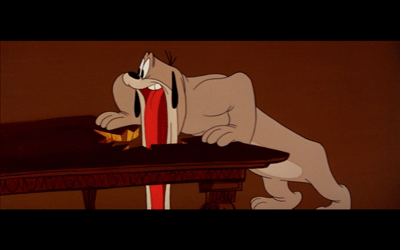
Jamie S. Rich is a novelist and comic book writer. He is best known for his collaborations with Joelle Jones, including the hardboiled crime comic book You Have Killed Me, the challenging romance 12 Reasons Why I Love Her, and the 2007 prose novel Have You Seen the Horizon Lately?, for which Jones did the cover. All three were published by Oni Press. His most recent projects include the futuristic romance A Boy and a Girl with Natalie Nourigat; Archer Coe and the Thousand Natural Shocks, a loopy crime tale drawn by Dan Christensen; and the horror miniseries Madame Frankenstein, a collaboration with Megan Levens. Follow Rich's blog at Confessions123.com.
|
| Popular Reviews |
| Sponsored Links |
|
|
| Sponsored Links |
|
|
| Release List | Reviews | Shop | Newsletter | Forum | DVD Giveaways | Blu-Ray | Advertise |
|
Copyright 2024 DVDTalk.com All Rights Reserved. Legal Info, Privacy Policy, Terms of Use,
Manage Preferences,
Your Privacy Choices | |||||||









